Uncovering a hidden composition behind Gauguin's “Poèmes Barbares''
Known for his use of symbolism and his syphilis, the post-impressionist artist Paul Gauguin is perhaps most famous for his work made in French Polynesia. Gauguin went to Tahiti in two trips, first in 1891, returning to France in 1893, and then again in 1895. He stayed until he died in the Marquesas Islands in 1903.
Kate Smith is a conservator of paintings and the head of the paintings lab at the Straus Center for Conservation and Technical Studies at the Harvard Art Museums. She says that there’s a clear distinction between Gauguin’s work on his first and second trip. When he first travels to Tahiti, Smith says his work was more documentary in nature.“He painted the people riding their horses, he painted the ocean, he painted people fishing, he painted all the different plants that he'd never heard of,” Smith says.
But when he returns to Tahiti in 1895, Smith says his work focuses more on Tahitian spiritual practices.“He's starting to paint... philosophical and spiritual pictures of his interpretation of the culture and the religion,” Smith says.
The Harvard Art Museums has a painting that Smith says really encapsulates Gauguin’s time in Tahiti. The painting in question is “Poèmes Barbares'' by Paul Gauguin. Painted in 1896 on his final trip to Tahiti, the piece depicts an angel and an animal god, combining imagery from Tahitian, Christain and Buddhist traditions. The colors are warm, dark and saturated.But below the surface of “Poèmes Barbares” lies a second, hidden landscape composition with riders on horseback that a team at the Straus Center for Conservation and Technical Studies at the Harvard Art Museums was able to uncover with the help of the Center for Scientific Studies in the Arts (NU-ACCESS). NU-ACCESS published a May 2021 paper in Spectrochimica Acta Part A: Molecular and Biomolecular Spectroscopy on the use of Uniform Manifold Approximation and Projection (UMAP) in the spectral imaging of “Poèmes Barbares.”
Both the lower and upper compositions of “Poèmes Barbares” were painted on Gauguin’s second trip. However, the documentary nature of the landscape with the riders on horseback in the lower composition seems similar to Gauguin’s other work on his first trip. The spiritual imagery of the upper portrait is characteristic of his second trip. Smith says both compositions together in a way sum up the entirety of Gauguin’s work and time in Tahiti.“It's sort of like the painting contains his whole trip,” Smith says.
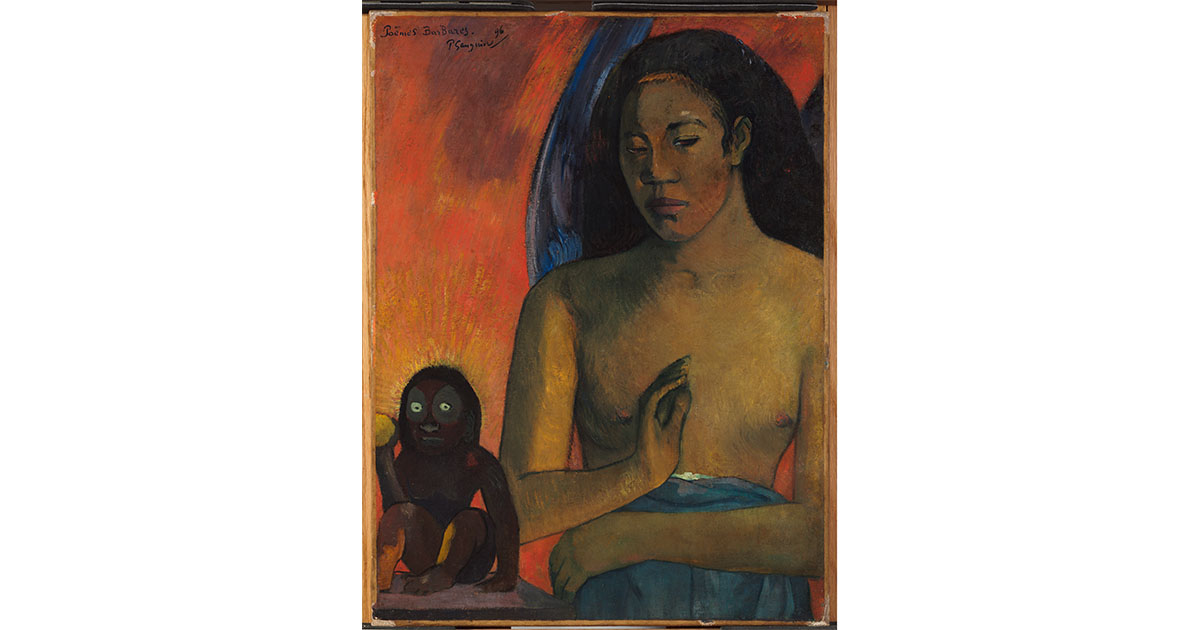
The story of the discovery of the painting’s hidden composition begins in 1950 when it was bequeathed to Harvard by Maurice Wertheim. “Poèmes Barbares” is one of 26 paintings in Wertheim’s collection at the Harvard Art Museums. He stipulated that the pieces must always be on display and shown together in a single gallery.
Pieces can only be removed from exhibition for no longer than 90 days, which Smith says made it difficult to study them in-depth. An opportunity for a “loophole” came when the museum buildings were closed for renovation and expansion from 2008 to 2014.
“Suddenly, we had all these paintings in storage, and we had access to them,” Smith says.
According to Smith, each painting in the Wertheim collection was imaged using a technique called X-radiography to help reveal its inner structure (similar equipment as used to image bones in the human body), infrared reflectography helped the conservators to look for underdrawings or preparatory work made by the artist, and a microscopic exam of the surface to understand the paint layers and buildup.
From visual inspection of the Wertheim collection, the team had always suspected that some of the paintings had interesting features below the visible compositions that scientific analyses might help reveal, but “Poèmes Barbares” had not been one of them.
“The Gauguin [“Poèmes Barbares”] doesn't present as having anything unusual going on. The surface texture corresponds with the composition on the surface,” Smith says. “So we thought, ‘We'll just get an X-ray taken of the canvas weave and move on.’”
But in 2012, after looking at the X-ray, they realized something was indeed unusual as the image did not correspond at all to the surface composition. According to Smith, just like an x-ray of your body, an x-ray of a painting is mapping density. Your bones appear white on an x-ray because they are denser than your muscles. An x-ray of a painting similarly shows the density of the pigments used.
Pigments composed of heavy elements like lead in the pigment lead-white (PbCO₃) or mercury in vermillion (HgS) will appear as a lighter hue on the X-ray because they are denser and are lower on the periodic table. Organic pigments or pigments composed of lighter elements will appear darker in the X-ray image.
“So you expect it to look like a black and white rendition, to some degree, of the composition,” Smith says.
The team expected the orange and red background of “Poèmes Barbares” to be composed of the pigment vermillion and thus it would appear lighter on the X-ray due to the relatively high density of mercury, but instead, the image contrast bore no resemblance to the surface composition. After a week of puzzling over the X-ray, Smith flipped it sideways and suddenly a landscape appeared.
“Your brain is so interesting,” Smith says. “We just flipped it 90 degrees, and it started to feel more like a landscape.”
Smith says the x-ray reveals what looks like trees or clouds in the background of the hidden, lower composition, and her colleague, Teri Hensick, noticed what looked like two riders on horseback.
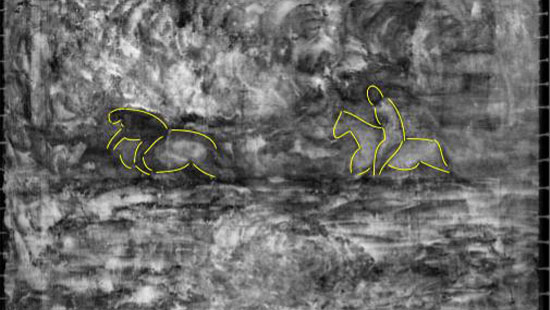
To probe more below the surface of the painting the team turned to X-ray fluorescence (XRF) analysis. XRF analysis involves shining an X-ray beam at an object and collecting the emitted fluorescence . The different wavelengths of the X-ray light collected can be used to characterize the elements present in the underlying materials.
XRF can analyze not just the visible exterior, but has deep penetration into the painting from front to back, so this technique was especially useful in identifying the elements, and therefore the pigments, within the lower composition.
“In paintings with multiple layers, each of which can contain several pigments with different elemental compositions, the XRF spectrum has numerous x-ray peaks. Once the elements are identified in the spectrum, the pigments present can be suggested from the elemental patterns,” says Katherine Eremin, the Patricia Cornwall senior conservation scientist at the Straus Center who was brought in to do the point XRF analysis.
The Harvard Art Museums has an XRF unit that can only look at specific points on a painting. According to Eremin, they focused on points of the surface close to the edges of the painting where you could see the paint layers of the lower compositions. However, they soon found out the data didn’t elucidate very much.
“It became obvious that you could get a certain amount from the point [XRF] analysis, but it was very limited,” Eremin says. “But we're never really going to be able to get an idea of what the sort of structure underneath was, what the underlying painting looked like.”
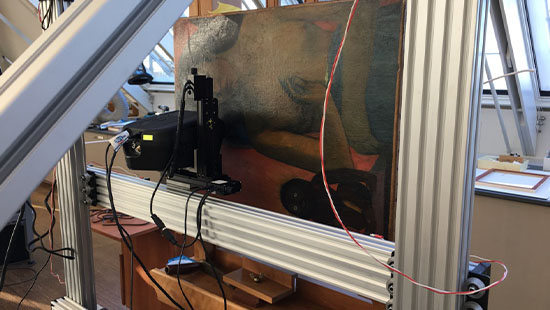
But there was a technique that would allow them to conduct XRF analysis across the canvas called macro X-ray fluorescence (MA-XRF) scanning. At the time, Smith says MA-XRF scanning was just coming into fashion, and the Harvard Art Museums did not have a MA-XRF scanner. The team thought that if they could get their hands on a MA-XRF scanner it could better indicate the pigments used across the canvas, Smith says.
But at this point, the newly renovated Harvard Art Museums were open and the stipulations of the Wertheim collection now applied. According to Smith, the 90-day window where the painting could be removed from display did not give very much time to pack and ship the painting to a place with a MA-XRF scanner.
That is why the team turned to NU-ACCESS for help in 2016. NU-ACCESS has a mobile MA-XRF scanner and hyperspectral imaging (HSI) unit for the purpose of partnering with institutions that don’t normally have those tools and techniques at their disposal. NU-ACCESS brought both to the Harvard Art Museums, and Smith says the MA-XRF scanner ran 24 hours a day, for three days to scan the entire canvas, save a small strip at the bottom.
The MA-XRF scanner was able to yield elemental maps of the canvas that could point to the location of certain pigments. For example, according to Smith, the mercury map corresponded with the team’s suspected use of the pigment vermillion in the background and the angel’s lips. But there were also small shapes showing concentrations of mercury that didn’t correspond to where vermillion was visibly present in the surface composition. This could point to the use of a pigment containing mercury in the lower composition.
“So we just started noting those kinds of differences. ‘What's here that doesn't correspond to what we can see with our eye?’” Smith says
But it was the MA-XRF map of tin that presented one of the biggest mysteries of the project. According to Smith, the map showed a strong tin response in the area of the angel’s blue sarong, but the only oil paint pigment in which tin is present is cerulean blue made from cobalt stannate. However, according to the MA-XRF analysis, there was no indication of the presence of cobalt in the sarong, which meant the pigment used was most likely not cerulean blue.
“But the sarong itself is blue. So why is it blue?” Smith says. “There are no other blues that contain tin.”
The strong presence of lead in the sarong indicated the use of lead white mixed with another pigment, but that pigment remained unknown. The team searched the other element maps for some indication of the blue mystery pigment.
“All the maps were ruling out every blue known to man,” Smith says.
One answer to the tin conundrum came in the form of carmine, a red lake pigment made from a dye extracted from the cochineal insect. In the late 19th century, Smith says there was a particular carmine pigment that was cast using tin as a base, so that explained the strong presence of tin but inspired new questions since there was no visible red in the upper composition.
“There’s a blue color with no blue and a red result with no red,” Smith says.
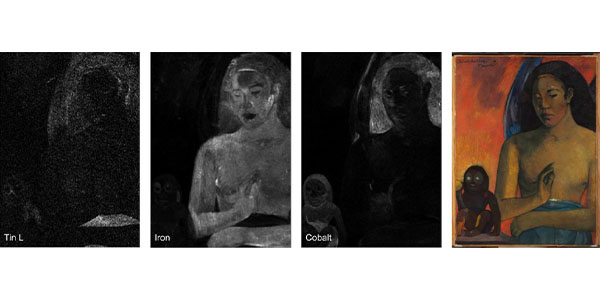
As the team struggled to answer questions with non-invasive techniques such as MA-XRF, they turned to analyzing cross sections of the painting which involves flaking off pieces of paint no bigger than a grain of sand. But they did not do this lightly.
“Taking samples from an object is a really big deal,” says Georgina Rayner, the associate conservation scientist at the Straus Center. Sampling the painting required extensive discussion and approval of the Harvard Art Museums curators, Rayner says.
Even after securing approval, removing cross sections does not mean slicing into a painting wherever you please.
“To take a sample we're using a surgical scalpel with a sharp point and gently prying a little bit of paint away from the surface,” says Rayner. “So areas of damage are good because there's generally cracks...so you can control how much of the sample will break away.”
Ultimately, Rayner and the team took 14 microscopic samples from the flaking edges of the canvas. These samples helped reveal the stratigraphy of the different paint layers and differentiate between the pigments in the upper and lower compositions.
“You could interrogate all the separate layers,” Eremin says.
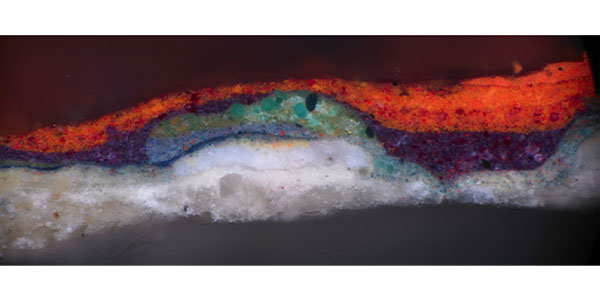
Through the analysis of the cross section, they found the presence of iron in the sarong which would indicate the pigment Prussian blue. The iron had not shown up in the MA-XRF scan of the sarong due to a limitation of the technique.
Eremin says that while the MA-XRF can usually penetrate all the layers of paint, it can be difficult for elemental information about the lower layers to be relayed back if the upper layers are composed of pigments with heavy metals, like lead or mercury, and the lower layers are composed of organic pigments or pigments with lighter elements, such as iron or chromium.
Because the blue pigment was mixed with a lead white, the lead was preventing the MA-XRF from detecting the iron in the Prussian blue.
“The lead quenches the signal of the iron. So all you get is a lead response and no iron response even though there is iron present,” Smith says.
So the original color of the sarong was the result of mixing lead white, Prussian blue and carmine using a tin base.
“So it would have been sort of a purpley color. Now it's this sort of greenish blue because all the red has completely faded away,” Smith says.
Smith says this not only answered a “forensic puzzle,” but it also gave insights into Gauguin’s original color palette.
“Right now it's got this greenish-blue...quality in the sarong in this cooler cobalt and ultramarine blue in the wings that kind of kind of sour each other a little bit,” Smith says. “But when you put a red cast over this [to make the sarong purple], the whole thing falls into color harmony again.”
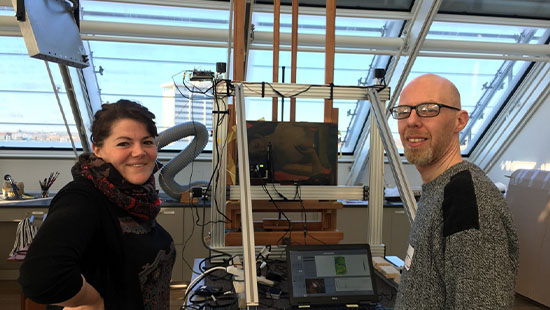
Using the shapes shown from the original X-radiograph, the cross section analysis and the elemental mapping from the MA-XRF analysis, Smith put together a rough sketch of hidden, lower composition with its suspected colors. Smith says the mercury in the vermillion background of the upper composition made it difficult for the MA-XRF to detect how far the yellow pigment extended into the canvas.
Meanwhile, members of NU-ACCESS have been combing through the HSI data using statistical analysis to yield more information about the painting.
Due to the COVID-19 pandemic, the Harvard Art Museums are closed, which means Smith and the team have had more time to analyze the painting than the usual 90-day window would allow. Currently, she has been removing the painting’s varnish, which Smith says Gauguin would not have applied. Eremin says the varnish is disfiguring the painting, and a byproduct of its removal is the uncovering of some cracks away from the edges of the painting.
“Suddenly, we have access to the center of the painting. There are old losses and cracks and things that we can take samples from.” So Smith hopes to do one more round of samples and then publish in a year what the results of all the analyses mean art historically.
From an art-historical perspective, Smith is excited about what the scientific analyses could reveal about Gauguin’s process and frame of mind.
“What really fires me up is that this kind of investigation can reveal decision-making,” Smith says. “Even looking microscopically at a cross section getting that swirling look, looking at him working quickly and fast, and then working slow and methodical.”
From a scientific point of view, Eremin says the project shows how one type of analysis can’t tell you everything.
“You need lots and lots of different techniques and this kind of multidisciplinary collaboration,” Eremin says. “You can't just use one scientific technique and hope to have all the answers.”
Eremin stresses how vital NU-ACCESS and its MA-XRF scanner were in this project.
“It was such a fantastic opportunity to find out more with equipment that we didn't have,” Eremin says.
According to Smith, it has been great to work with NU-ACCESS to mull things over together.
“That kind of multidisciplinary collaboration is where it gets really rich and interesting,” she says.
Overall, Smith believes that forensic investigation of art can be a non-intimidating way into art that may often seem unapproachable or even elitist.
“You start to think of paintings as things made of stuff by people, instead of a theoretical construct that you have to understand by some magical beam of whatever,” Smith says. “There's a potential there to humanize art by reminding ourselves that it's made up stuff and that it changes over time.”
